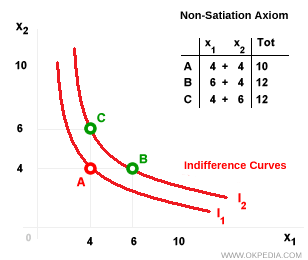Non-Satiation Axiom
The non-satiation axiom is a core principle in consumer theory. It states that, all else being equal, a rational consumer will always prefer a bundle that contains a greater quantity of at least one good. In other words, more is always better. This axiom is typically illustrated using a Cartesian diagram with parallel indifference curves.

In the diagram, bundles A and B contain the same amount of good X2 (bread). However, bundle B includes a larger quantity of good X1 (apples). Given the choice, and assuming no other changes, a rational consumer will prefer bundle B because it offers more of good X1 without reducing the amount of good X2. The same reasoning applies when comparing bundle A with bundle C. In both cases, bundles B and C are preferred to A because they offer more of one good without any trade-off in the other. The additional quantity of goods in bundles B and C yields a higher level of satisfaction, as measured by the utility function.
 Preference for Higher Indifference Curves. The non-satiation axiom also underpins the consumer's preference for indifference curves that lie further from the origin. The outer indifference curve I2 corresponds to a higher consumption level of at least one good, holding the others constant, and therefore represents a higher utility level than the inner curve I1.
Preference for Higher Indifference Curves. The non-satiation axiom also underpins the consumer's preference for indifference curves that lie further from the origin. The outer indifference curve I2 corresponds to a higher consumption level of at least one good, holding the others constant, and therefore represents a higher utility level than the inner curve I1.
 Why It's Called “Non-Satiation”. The term “non-satiation” reflects the idea that a satiated consumer - one who has no desire for additional quantities - would no longer favor bundles that offer more. In such cases, bundles located on higher indifference curves (i.e., with more of at least one good) would cease to be preferred.
Why It's Called “Non-Satiation”. The term “non-satiation” reflects the idea that a satiated consumer - one who has no desire for additional quantities - would no longer favor bundles that offer more. In such cases, bundles located on higher indifference curves (i.e., with more of at least one good) would cease to be preferred.
